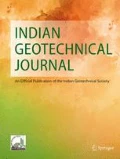Abstract
Contiguous bored piles 80 cm in diameter with ground anchors were designed as retaining wall for a deep excavation. Inclinometers were utilized to monitor displacements. The maximum depth of excavation is 25 m, and the subsoils are composed of stiff clays with high plasticity. Design calculations were made by the two-dimensional finite element program Plaxis. The bored pile walls showed a fairly good displacement performance, being on the safe side under ordinary design conditions in which the ground anchors are perpendicular to the retaining walls. Diagonally positioned ground anchors were designed at a convex corner of the project to prevent the ground anchors from intersecting. Designing these diagonal ground anchors at the convex corner prevented stiff wall behaviour in this case. The deformation modulus is the key parameter for accurately predicting displacements. Back analyses of the retaining walls were executed based on measured displacements, and new deformation modulus values were found by using the actual displacements in Plaxis. These findings were compared with the deformation modulus values calculated by using some correlations based on the undrained shear strength given in the literature. Thus, correlations using the measured displacements of a deep excavation project are recommended for highly plastic clays.











References
Clough GW, O’Rourke TD (1990) Construction induced movements of in-situ walls. In: Design and Performance of Earth Retaining Structure, Proceedings of Specialty Conference, Geotechnical Special Publication No.25, ASCE, New York.
Carder DR (1995) Ground movements caused by different embedded retaining wall construction techniques, Transport. Res. Lab. Rep., 172, Berkshire, U.K.
Long M (2001) Database for retaining wall and ground movements due to deep excavations. J Geotech Geoenviron Eng ASCE 127(3):203–224
Lam SY, Haigh SK, Bolton MD (2014) Understanding of ground deformation mechanisms for multi-propped excavation in soft clay. Soils Found 54(3):296–312
Dong Y, Burd HJ, Houlsby GT (2017) Finite element study of deep excavation construction processes. Soils Found 57(6):965–979
Duncan JM, Buchignani AL (1987) An engineering manual for settlement studies. Virginia Polytechnic Institute and State University, Virginia, Centre for Geotechnical Practice and Research
Clayton CRI (1995) The Standard Penetration Test (SPT): Methods and Use, CIRIA Report 143. Construction Industry Research Information Association, London
Brinkgreve RBJ, Broere W, Waterman D (2006) User’s Manual of the 2-D Program Plaxis Version 8.6: A Finite Element Code for the Two-Dimensional Analysis of Deformation and Stability in Geotechnical Engineering. Delft, The Netherlands.
Terzaghi K, Peck RB (1967) Soil mechanics in engineering practice, 2nd edn. Wiley, New York
NAVFAC DM-7.2 (1986) Foundations and earth structures. Design Manual 7.2, Department of the Navy, Naval Facilities Engineering Command, Virginia.
BS 8002 (1994) Code of Practice for Earth Retaining Structures. British Standard, London
Author information
Authors and Affiliations
Corresponding author
Additional information
Publisher's Note
Springer Nature remains neutral with regard to jurisdictional claims in published maps and institutional affiliations.
Rights and permissions
About this article
Cite this article
Ünver, M., Ünver, İ.S. Monitoring of a Deep Excavation Supported by Anchored Retaining Walls. Indian Geotech J 52, 227–236 (2022). https://doi.org/10.1007/s40098-021-00544-5
Received:
Accepted:
Published:
Issue Date:
DOI: https://doi.org/10.1007/s40098-021-00544-5

